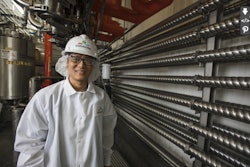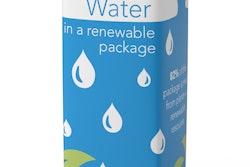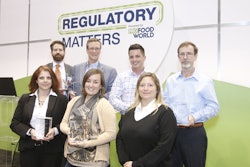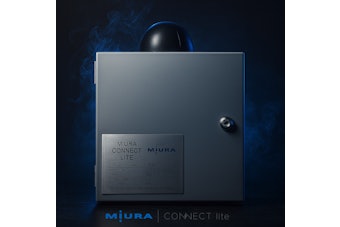Generosity is a hallmark of the winners of the 2016 Sustainability Excellence in Manufacturing Awards, who were honored at this year’s ProFood Tech in April. Whether it was sharing successful ideas within a company, or even between potential competitors, the winners often received a helping hand from others before them who had found ways to manufacture food, beverages and consumer products more sustainably. In turn, they’re also paying these ideas forward to help others innovate.
Sponsored by the PMMI’s OpX Leadership Network, the awards honor exceptional sustainability achievements within manufacturing operations. These peer-reviewed awards seek to honor companies that go beyond simple environmental compliance to achieve sustainable ways to drive improved business performance.
The OpX Leadership Network is a community of manufacturing, engineering and operations professions dedicated to operational excellence. It provides a forum to identify and solve common operational challenges, and apply best practices and innovative solutions to the real-world context of manufacturing.
The 2016 winners for projects and programs conducted from 2015 through 2016 are, in the Projects category, Snyder’s-Lance, Inc., Perry, FL, first place; Pepperidge Farm, Inc., Bloomfield, CT, second place; and Keystone Foods, Camilla, GA, third place. In the Program category, the winners are Smithfield Foods, Arnold, PA, first place; Smithfield Packaged Food Group, Kinston, NC, second place; and Sierra Nevada Brewing Co., Mills River, NC, third place.
Reclaiming process water
Snyder’s-Lance
Perry, FL
Project, 1st Place
It takes a lot of water to peel potatoes mechanically. By finding a way to reclaim and reuse the water from its peeling process, the Snyder’s-Lance potato chip manufacturing plant in Perry, FL, both dramatically reduce its use of fresh water and produce cleaner peeled potatoes. The plant also lowered its wastewater treatment costs.
The project was driven by a company-wide search for cost-saving initiatives and sustainability-minded ideas, according to Wesley McGhee, corporate environmental engineer. “The reaction from employees to this project has been really positive. It’s sparked their imaginations, and they’ve been coming forward with their own ideas for additional projects to use less water or improve other plant processes. They see it as an investment in their plant, a way of expressing ownership.”
The plant partnered with Vanmark Equipment, which developed the first commercial potato peeler in 1954, to design and install equipment to reuse water on the spot in the peeling operation for both of its potato chip lines. The plant makes potato chips for the Cape Cod and Toms brands.
A steady stream of water is needed to feed the peelers. By splitting the spray bar inside the peeler, water can be returned, after being filtered to remove large fines and starch, to the first three of four spray nozzles. The fourth nozzle feeds fresh water as a final rinse and makeup water before potatoes leave the peel chamber.
“The project not only reduced the amount of fresh water required from 15 gpm to an average of 2 gpm going to each peeler, but by returning the water that’s captured we have effectively increased the amount of water pressure going through each spray bar, resulting in a higher peel removal,” explains McGhee.
Reducing the amount of water required for peeling also reduces the amount of wastewater that needs to be treated, as well as chemical usage, discharge water costs and man-hours. “Since the starch is removed at the water reclamation unit, as opposed to being removed at water treatment as sludge, it can be recycled as organic waste, which is less costly and more environmentally friendly,” he says.
The project was submitted for funding in October 2015 and went online in January 2016. Equipment and installation costs totaled $250,00, contrasted with an estimated $55,000 in annual water savings and additional savings at wastewater treatment. The project is on track to save more than 4 million gallons of water annually from the potato peeling operations. McGhee estimates a payback period of five years or less.
While the project was similar to one at the company’s plant in Cape Cod, MA, it was tailored for the overall scope of the Perry location and included additional automation and control. “The design aim at our other facility was compliance with daily discharge limits for wastewater and water usage, but our priority at Perry was reducing costs,” he says.
“We’ve learned several things since the reclamation system was installed,” adds McGhee, “including the importance of cleaning spray nozzles during sanitation periods, as well as managing feed rates at a related defoamer to keep the area clean.”
Clean power from fuel cells
Pepperidge Farm
Bloomfield, CT
Project, 2nd Place
A reliable power source is essential for any manufacturing process, but electrical grid power, with its dips and sags, can sometimes cause machines to stutter or fail. The Pepperidge Farm bakery in Bloomfield, CT, eliminated that problem by installing fuel cells that deliver ultra-clean and reliable power from natural gas.
As an additional benefit, “The high-quality heat from the fuel cells is utilized to generate hot water and to preheat supply air entering the thermal oxidizer used for VOC destruction,” explains Harry Pettit, senior project manager for controls and environmental management at the facility, which is part of the Campbell Soup Company.
A second fuel cell was installed at the plant in 2016. Together they generate 2.6 megawatts of clean and continuous on-site power plus heat for the 260,000-sq.-ft. facility. The fuel cells provide 90 percent of the plant’s electricity needs, with another 10 percent coming from a 1 MW solar array.
Since the fuel cell power generation process avoids combustion and so is virtually pollutant-free, it helps advance Pepperidge Farm’s sustainability goals, which include generating 40 percent of its electricity needs through renewable energy. The fuel cells have a compact footprint and operate quietly, which are additional benefits.
By using fuel cell power, the environment annually avoids 43 tons of smog-producing nitrogen oxide (NOx), 98 tons of sulfur dioxide (Sox) that causes acid rain, and 4,500 pounds of particulate matter that can aggravate asthma, according to Pettit.
Construction on the new fuel cell system began in late 2015 and was completed nine months later. The aggregate electricity generation rate will be $.02/kwh less than the rate sourced from the grid, delivering a projected ROI of 18 percent. The fuel cells are expected to generate 10 million kWh of electrical power every year. At the end of its life, approximately 93 percent of the power plant will be re-used or recycled.
Pepperidge Farm will be able to sell low emission renewable energy credits for other companies and the local electric utility to use. And because fuel cells use less water to produce energy than a conventional power plant, approximately 42 million gallons of water per year will be conserved in the generation of electricity. Heat recovered from the fuel cell exhaust is sent through a heat recovery steam generator to make hot water, which is used in the process and for cleaning, as well as heat for VOC destruction.
The project was awarded a contract under the Eversource Low and Zero Emissions Renewable Energy Credit program, which allows for the sale of renewable energy credits for each megawatt hour of power produced.
Antibiotic-free hatchery
Keystone Foods
Camilla, Georgia
Project, 3rd place
Sometimes traditional methods turn out to be the best way to solve a problem. That was the case at the Keystone Foods chick hatchery in Camilla, GA. When the facility responded to customer requests for antibiotic-free processes in January 2015, chick mortality rates immediately began to increase dramatically.
Mortality rates rose to 1.84 percent in the first week. When you’re hatching out 1.4 million chicks every week, numbers like these can quickly add up to significant financial losses. It also raised concerns over animal welfare.
Hatchery Manager Truman Henderson and his team immediately began evaluating ways to reverse the trend and identify the root cause of the problem. They began a full-scale analysis of every part of their process, looking for ways to improve incubation time, egg moisture loss, ventilation and egg pack. Henderson also visited other antibiotic-free hatcheries seeking alternative methods to improve chick quality.
“While different chemical solutions were being used, we ultimately decided to spray a dilute 1.7 percent solution of hydrogen peroxide inside the hatcher to improve the environment and protect the new born chicks,” Henderson explains. “This is a much lower percentage than in the bottles of hydrogen peroxide found on grocery store shelves.”
The facility already had a fogging system installed in the hatchers that had not been used for several years. It was easily restored to operation and the diluted hydrogen peroxide is now sprayed for three minutes every hour during the hatch window.
More than just a relatively simple switch from antibiotics to a chemical solution, Henderson says the facility gained great value from its full-scale re-evaluation of every aspect of its hatching process.
“It’s important to re-examine your processes periodically to see if something’s not working anymore,” he says. “We checked, monitored and measured everything, from set times to ventilation. Then we retrained and refocused employees to ensure the right results would be achieved with the hydrogen peroxide spray. It’s given us a much tighter operation.”
The full potential of the project was realized one year later after a complete service, overhaul and retraining of employees. Chick mortality rates have been comparable to hatcheries using antibiotics since January 2016, and Keystone Foods has been able to maintain its commitment to an antibiotic-free hatching operation.
Henderson says the project saves the hatchery an estimated $140,000 annually in wasted resources, including energy and water usage, as well as transportation and disposal costs. The findings were shared with two other Keystone hatcheries, which have now achieved similar results using a hydrogen peroxide spray.
Reducing chemical use
Smithfield Foods
Arnold, PA
Program, 1st Place
When Ryan Postlethwait joined the Smithfield Foods facility in Arnold, PA, as its first wastewater treatment supervisor, he discovered that operators weren’t tracking the data generated at the facility. His second discovery was that more than $150,000 was being spent annually for aluminum chloride, the biggest budget expense and one that seemed out of line for a small treatment plant.
The treatment process begins by distributing wastewater from the manufacturing process into a heated decant to separate out the grease generated by cooking meat. Large solids are filtered out with a rotary screen, and additional suspended solids and grease are removed in a dissolved air floatation unit through a chemical addition. The grease from these treatment stages is sold for recycling, and other companies often use it as a fuel source.
A coagulant and sludge de-watering agent, aluminum chloride, is used to reduce turbidity and clarify water. By determining the correlation between turbidity and total suspended solids values, Postlethwait calculated the appropriate dosage based on water conditions. An inexpensive turbidity meter was installed, which provides operators with quick, quantitative results for gauging water clarity.
“The operators are skilled and experienced, but they had no way to accurately measure the effectiveness of aluminum chloride dosing before we installed the turbidity meter,” explains Postlethwait. “We spent $1,425 for a turbidity meter and $25 for weekly turbidity tests, allowing us to achieve nearly $300 in daily savings in chemical costs. By no longer over-treating the wastewater from the process, we’ve been able to reduce the use of aluminum chloride by 50.2 percent.”
The project took two months from start to finish, with a payback period of just five days. The plant reduced its daily usage of aluminum chloride from a 2015 average of 143.8 gallons to just 71.6 gallons per day with accurate dosing. That equals a chemical cost savings of $108,704 per year and an annual reduction in aluminum chloride use of 26,353 gallons.
“Our biggest challenge was to reduce chemical use while still maintaining water quality that meets permit limitations,” says Postlethwait. “We have to monitor and report CBOD5, pH, total suspended solids, and oil and grease results every week. It’s important to properly train operators on these permit limitations and how they relate to the new operating parameters, because reducing chemicals by too much could cause us to violate permit limits.”
Protecting water quality
Smithfield Packaged Food Group
Kinston, NC
Program, 2nd Place
When Smithfield doubled the size of its facility in Kinston, NC in 2013, the goal was to produce a wider range of products, including injected hams and hot dogs. But the growth presented a challenge that caused plant managers to come up with an innovative solution.
Soon after the expansion, the plant received the first of what would ultimately be four notices that it had exceeded one of its effluent limitations for biochemical oxygen demand (BOD) contained in its city wastewater permit. The source of the problem turned out to be the pickling solution draining from the hanging hams, which was entering the wastewater drains from the process.
“At first, we tried to solve the problem by installing sump pumps in the drains, where the pickle was captured and sent to a landfill for disposal,” explains Charlie Prentice, the facility’s environmental coordinator. “But we soon realized that dumping the pickle in the landfill, even though it was solidified with wood chips, was not the best environmental solution.”
Still searching for a better way, Prentice next had the pickling solution tested. “It turned out that the pickling solution had a very high BOD content that was putting us out of compliance,” he says.
“We talked to a sister facility that used a different formulation and ran some R&D tests on it. Then we brought in our engineering and environmental experts to test the new formulation for BOD content.” A better way had been found and was implemented in June 2015.
The solution involved changing the pickling solution formulation and eliminating one high BOD ingredient and switching to a different preservative. The taste and quality of the final product hadn’t changed, but the plant was now in compliance. “We’re actually making a better ham for people as a result,” he adds.
The annual cost savings for the facility have been enormous, adding up to nearly $3 million: $1,057,503 for ingredient elimination, $1,469,711 for preservative change, $165,240 for pickle disposal and $301,742 in reduced sewer discharge fees.
“Many times, the cost of running an onsite wastewater treatment system is not taken into consideration when evaluating the cost of introducing a new product or using new ingredients,” says Prentice. “Treating wastewater is double or triple the cost of purchasing fresh water.”
It’s ideas like these that he hopes other environmental coordinators within Smithfield will “steal” at the company’s next annual environmental conference.
CO2 recovery and reuse
Sierra Nevada Brewing Co.
Mills River, NC
Program, 3rd Place
A closed-loop approach to sustainability has been a way of life at Sierra Nevada Brewing Co. since its founding in Chico, CA, more than 35 years ago. By eliminating waste and reusing or recycling resources from its production processes, the company has been able to minimize its environmental footprint and reduce costs in every part of its operations.
Its new brewery in Mills River, NC, is the latest beneficiary of this sustainability commitment, enabling it to recover CO2 generated in its fermentation cellar and reuse it in other processes at the facility. The brewery uses CO2 to move product from tank to tank, to purge tanks and for cleaning processes. During packaging, it’s used to displace oxygen in bottles and cans, which maintains product quality.
“CO2 recovery was always part of the plan at Mills River from the earliest design stage. It was just a question of timing,” explains Cheri Chastain, sustainability manager. “Rapidly growing customer demand let us expand the size of the fermentation cellar sooner than we had expected, so enough volume was being generated to make recovery feasible financially. We haven’t needed to purchase CO2 at Mills River since the project was completed in September 2016.”
At projected 2017 production levels, the brewery expects to save $450,000 annually in CO2 purchases, a total of 5.3 million pounds of CO2 every year. The total program cost was $1.135 million, and the brewery anticipates a payback period of 2.5 years.
“Washing is traditionally used to clean captured CO2, but that’s a water-intensive process,” says Chastain. “By setting up a water recovery system in conjunction with CO2 recovery, we were able to ensure that this program had a net zero impact on the facility’s water consumption. While this program actually increases electricity usage for the facility, it has avoided the electricity needed to generate the CO2 we were purchasing and the cost of transporting it to the brewery.”
The Mills River project was modeled after a system implemented at the Chico brewery in 2005, which was the first of its kind at an American brewery in the lower 48 states. The system was taken a step further in North Carolina by reclaiming the wash water for reuse in cooling towers.
“Recovering and reusing the wash water makes our CO2 recovery system incredibly efficient,” she adds, “and it was something we hadn’t been able to do at Chico due to the location of the CO2 recovery system in relation to water reuse points and other infrastructure issues. By taking this into account when designing the NC brewery, it helped make programs like this easier to implement.”
Please visit www.profoodworld.com for information about the 2017 Sustainability Excellence in Manufacturing Awards. Details about the submission process will be announced in the Fall of 2017.






















